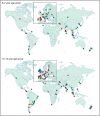Meteorological conditions, climate change, new emerging factors, and asthma and related allergic disorders. A statement of the World Allergy Organization
- PMID: 26207160
- PMCID: PMC4499913
- DOI: 10.1186/s40413-015-0073-0
Meteorological conditions, climate change, new emerging factors, and asthma and related allergic disorders. A statement of the World Allergy Organization
Abstract
The prevalence of allergic airway diseases such as asthma and rhinitis has increased dramatically to epidemic proportions worldwide. Besides air pollution from industry derived emissions and motor vehicles, the rising trend can only be explained by gross changes in the environments where we live. The world economy has been transformed over the last 25 years with developing countries being at the core of these changes. Around the planet, in both developed and developing countries, environments are undergoing profound changes. Many of these changes are considered to have negative effects on respiratory health and to enhance the frequency and severity of respiratory diseases such as asthma in the general population. Increased concentrations of greenhouse gases, and especially carbon dioxide (CO2), in the atmosphere have already warmed the planet substantially, causing more severe and prolonged heat waves, variability in temperature, increased air pollution, forest fires, droughts, and floods - all of which can put the respiratory health of the public at risk. These changes in climate and air quality have a measurable impact not only on the morbidity but also the mortality of patients with asthma and other respiratory diseases. The massive increase in emissions of air pollutants due to economic and industrial growth in the last century has made air quality an environmental problem of the first order in a large number of regions of the world. A body of evidence suggests that major changes to our world are occurring and involve the atmosphere and its associated climate. These changes, including global warming induced by human activity, have an impact on the biosphere, biodiversity, and the human environment. Mitigating this huge health impact and reversing the effects of these changes are major challenges. This statement of the World Allergy Organization (WAO) raises the importance of this health hazard and highlights the facts on climate-related health impacts, including: deaths and acute morbidity due to heat waves and extreme meteorological events; increased frequency of acute cardio-respiratory events due to higher concentrations of ground level ozone; changes in the frequency of respiratory diseases due to trans-boundary particle pollution; altered spatial and temporal distribution of allergens (pollens, molds, and mites); and some infectious disease vectors. According to this report, these impacts will not only affect those with current asthma but also increase the incidence and prevalence of allergic respiratory conditions and of asthma. The effects of climate change on respiratory allergy are still not well defined, and more studies addressing this topic are needed. Global warming is expected to affect the start, duration, and intensity of the pollen season on the one hand, and the rate of asthma exacerbations due to air pollution, respiratory infections, and/or cold air inhalation, and other conditions on the other hand.
Figures






References
-
- Samet JM, Noah TL, Devlin RB, Yankaskas JR, McKinnon K, Dailey LA, et al. Effect of ozone on platelet activating factor production in phorbol-differentiated HL60 cells, a human bronchial epithelial cell line (BEAS S6) and primary human bronchial epithelial cells. Am J Respir Cell Mol Biol. 1992;7:514–22. doi: 10.1165/ajrcmb/7.5.514. - DOI - PubMed
Grants and funding
LinkOut - more resources
Full Text Sources
Other Literature Sources
Medical

